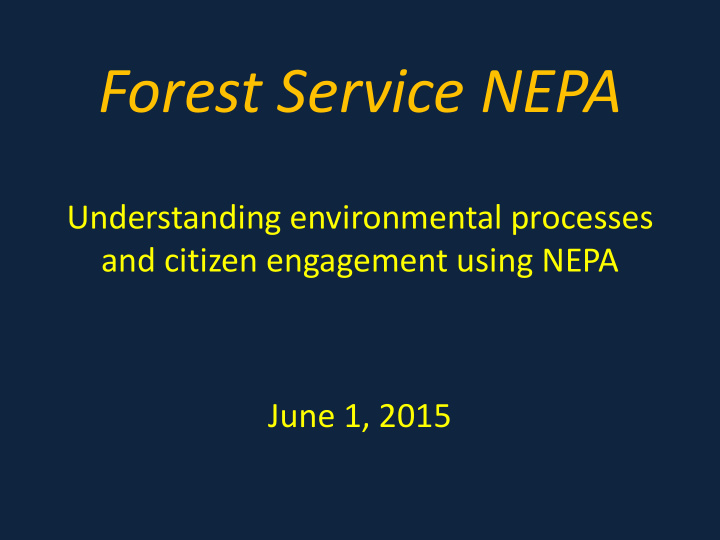



Forest Service NEPA Understanding environmental processes and citizen engagement using NEPA June 1, 2015
Topics 1. Levels of Forest Service NEPA analysis. 2. Opportunities for public comment. 3. Objection process (36 CFR 218). 4. Sources of project-related information.
1. Levels of Forest Service NEPA A. Categorical exclusions B. Environmental assessments C. Environmental impact statements
A. Categorical exclusions • Involves proposals deemed to involve no extraordinary circumstances. • Includes construction and reconstruction of trails, minor special uses of FS lands, post-fire rehabilitation, and wetland restoration. • Not subject to the objection process (36 CFR 218). • Forest Service Handbook 1909.15, Chapter 30.
B. Environmental assessments • Undertaken to determine if an EIS is needed. • If analysis finds no significant impacts, a finding of no significant impact and decision notice are prepared. Otherwise, an EIS is started. • Subject to the objection process (36 CFR 218). • Forest Service Handbook 1909.15, Chapter 40.
C. Environmental impact statements • Highest level of analysis. Requires publishing notices in the Federal Register . • Finalized with a record of decision. • Subject to the objection process (36 CFR 218). • Forest Service Handbook 1909.15, Chapter 20.
2. Opportunities for public comment: Categorical exclusions • No legal notices are required for categorical exclusions. • Scoping is required and at the discretion of the responsible official. • Decision memos resulting from categorical exclusions are not subject to objections.
2. Opportunities for public comment: Environmental assessments • A 30-day scoping (or notice and comment). • An additional 30-day comment period on a draft EA may occur. • To have standing to object, a commenter must make “specific written comments.”
2. Opportunities for public comment: Environmental impact statements • A 45-day scoping period. • A 45-comment period on the draft EIS. • To have standing to object, a commenter must make “specific written comments.”
3. Objection process (36 CFR 218) • Objection process replaces the appeals process formerly at 36 CFR 215. • The project record can be supplemented until the decision is signed.
3. Objection process (36 CFR 218) • Objection period is 45 days, starting with posting of a legal notice for the availability of the draft decision notice or draft record of decision. • If an objection is received, there is an additional 45-day resolution period, after which the decision can be signed.
4. Sources of project-related information • Schedule of proposed actions (SOPA): www.fs.fed.us/sopa • Uinta-Wasatch-Cache NF project page: www.fs.usda.gov/projects/ uwcnf/landmanagement/projects
Recommend
More recommend